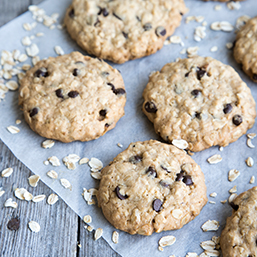
Being able to prepare healthy foods is an essential life skill that can feel overwhelming – not only to perform, but also to hand down to our littles. We know we need to teach children these skills, but often, having little helpers in the kitchen can make a task take longer. One way to overcome this hurdle is to start off small, prepare yourself (both emotionally and time-wise), and to see cooking as not only skill-building time, but also as playtime.
Oatmeal Breakfast Bites
With summer around the corner, a stumbling block for many families is quick and healthy breakfast and snack options. Having an on-the-go option is a great idea, and an opportunity to get your whole family involved in the cooking process. As an added bonus, many studies show that the opportunity to assist with cooking and interacting with recipe ingredients helps children to develop fewer food aversions, or to help them overcome aversions.
Oatmeal breakfast bites are the perfect solution for busy mornings, before- and after-practice snacks, and even for the lunch kit.
Ingredients
Adaptations
Need to make things egg-free? Try using a flax egg! Mix 1 tbsp of flaxseed meal and 2 ½ tbsp of water. Stir and let rest for 5 minutes to allow it to thicken.
Directions
Kids of any age can help set the kitchen timer. While the oatmeal bites are baking, encourage your kids to help with cleaning up. They can help put dishes into the sink or dishwasher, wipe counters, put away ingredients, and more depending on their ages.
Conversations
Cooking together doesn’t just provide a great opportunity for teaching the life skills your child needs! Use cooking time as an opportunity to work on math skills, communication skills, self-expression, and more. Here are some ideas of topics to discuss during recipe prep.
Kitchen safety. Talk about safely operating an oven. How do we know when the oven is safe? Where is it safe to touch? What safety tools do we have on hand? When using a knife to slice or chop ingredients, how do we keep ourselves and others safe? How do we hand kitchen tools to one another? Why do we wash our hands before cooking and after handling ingredients like eggs? When is it safe to taste?
Math skills. What do we do if we don’t have the right size of measuring cup? For example, my sugar container has a narrow opening and the 1 cup measure doesn’t fit inside – we can pour from the jar or we can use a smaller measuring cup multiple times. Challenge your school age kids to double or triple recipes and have them compare the different measuring cups - is 13 bigger or smaller than ½?
Communication skills. Encourage kids to sample ingredients that are safe to consume raw, like seasonings. Work on vocabulary by encouraging them to describe different tastes and textures, and to express their opinions of them. Food and sensory vocabulary-building is a great way to encourage your children to be able to share their needs and preferences around food.
Self-expression. Let kids dictate flavors where possible! In this recipe, allow kids to pick the fruits to add in and encourage them to communicate why they made those choices. Experiment with sensory experiences – do they like dried fruit better than fresh? Are canned pears more consistently sweet than fresh? Pre-plan adaptations for sensory-sensitive or sensory-seeking kids! If your child enjoys smushing things, clean hands are okay for working with bananas and shaping cookies. If your child has difficulty touching raw or squishy ingredients, gloves or kitchen tools might help. Encourage your children to try new sensory experiences, while being prepared to help them remove the sensation with hand washing if it is too intense for them. Cracking eggs is a great activity that many kids enjoy; to ensure shells stay out of the finished product, crack the egg into a separate bowl.
Healthy eating. Talk about the ingredients you are using. Why are bananas healthy? Encourage older kids to look into nutritional information or look up the important building blocks of food like potassium to learn how they help our bodies grow. Talk about how sweet things like chocolate and fruits make our brain feel happy. You can also touch on how oatmeal makes our bodies feel energized, and how the protein in oatmeal and peanut butter help fuel our bodies for a long time after eating – meanwhile, the carbohydrates in oatmeal and fruits help deliver quick bursts of energy. Talk about any recipe adaptations you need to make for your family’s needs, like reading labels carefully to ensure your ingredients are free of allergens.
Trista is a stay-at-home mom and loves to share her discoveries about how to make life in Calgary work for families of all kinds.
See our related articles:
Calgary’s Child Magazine © 2024 Calgary’s Child